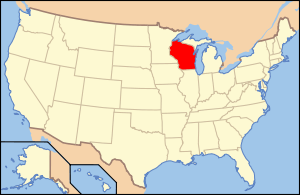Paleontology in Wisconsin

Paleontology in Wisconsin refers to paleontological research occurring within or conducted by people from the U.S. state of Wisconsin. Wisconsin has a relatively sparse fossil record. Fossils found in Wisconsin are generally very old, most ranging from 500 to 300 million years in age.[1] During the early part of the Paleozoic era, Wisconsin was covered by a warm, shallow sea that would be home to creatures like brachiopods, bryozoans, cephalopods, corals, crinoids, and trilobites. During the Silurian, Wisconsin was home to massive reef system that formed one of the most biodiverse habitats in all of North America at the time. The interval spanning the Permian, Mesozoic, Paleogene and Neogene are missing from the local rock record. During the Ice Age the local climate became cold. Seals, walruses, and whales left behind fossil remains in the state near the Great Lakes. On land, hemlock and spruce trees formed forests inhabited by creatures like giant beavers, horses, and woolly mammoths. The first fossil reef systems ever scientifically documented in North America were discovered in the area around Milwaukee. The Silurian reefs of the Milwaukee area were also the first known fossil reefs from the Paleozoic era. Their associated fauna is one of the most diverse from the period ever documented in North America. The Ordovician to Silurian trilobite Calymene celebra is the Wisconsin state fossil.
Prehistory

No Precambrian fossils are known from Wisconsin. As such, the state's fossil record does not begin until the Paleozoic. During the Cambrian period, Wisconsin was covered by a warm shallow sea.[2] During the Late Cambrian, Wisconsin's St. Croix County was home to algae, brachiopods, gastropods, trilobites, and worms. Algae fossils of this age were preserved in Dane County. Brachiopod fossils of this age were preserved in Dane County, Dunn County, Eau Claire County, Iowa County, Juneau County, Monroe County, Richland County, St. Croix County, Trempeleau County, Vernon County. Gastropod fossils of this age were preserved in Monroe County. Trilobite fossils of this age were preserved in Dane County, Dunn County, Eau Claire County, Iowa County, Juneau County, La Crosse County, Monroe County, Richland County, St. Croix County, Trempeleau County, and Vernon County. The worms left behind trace fossils like tubes and borings. Worm fossils of this age were preserved in Juneau County, La Crosse County, St. Croix County.[3]
The warm shallow sea inundating Wisconsin was still in place during the Ordovician.[2] About 460 million years ago Wisconsin was still home to brachiopods and trilobites. Their fossils preserved in Green Lake County.[4] Wisconsin was still covered in seawater during the Silurian.[2] The area around modern Milwaukee was a massive reef system. The fauna that lived there at that time is among the most diverse for its age on the entire continent. Donald G. Mikulic has called them "a textbook example of ancient reefs."[5]
The sea that had covered Wisconsin since the Cambrian persisted into the Devonian.[2] 390 million years ago Wisconsin was home to algae, brachiopods, corals, gastropods, ostracods, sponges, and trilobites. Algae of this age were preserved in Dane County. Brachiopods of this age were preserved in Dane County, Green County, Lafayette County. Corals of this age were preserved in Grant County and Lafayette County. Gastropods of this age were preserved in Grant County, Green County, Lafayette County. Ostracods of this age were preserved in Grant County, Green County, Lafayette County. Sponges of this age were preserved in Grant County. Trilobites of this age were preserved in Dane County Green County.
About 360 million years ago bryozoans were very abundant in Wisconsin. These and many other kinds of fossils were left behind in Brown County.[4] LaFayette County is also home to many fossils of this age.[6]
About 340 million years ago Wisconsin was home to brachiopods, bryozoans, cephalopods, corals, crinoids, cystoids, gastropods, pelecypods, sponges, stomatoporoids, and trilobites. Brachiopods of this age in Wisconsin were preserved in Door County, Fond du Lac County, Milwaukee County, and Ozaukee County. Bryozoans of this age in Wisconsin were preserved in Fond du Lac County, Milwaukee County, Ozaukee County. Huge cephalopods of this age in Wisconsin were preserved in Ozaukee County. Corals of this age in Wisconsin were preserved in Dodge County, Door County, Manitowoc County, Milwaukee County, Ozaukee County.[7] Crinoids of this age in Wisconsin were preserved in Ozaukee County, Racine County, and Waukesha County.[8] Crinoids were generally poorly preserved but north of Saukville coquina made of crinoid fossils can be found.[7] Cystoids of this age in Wisconsin were preserved in Racine County.[4] Gastropods of this age in Wisconsin were preserved in Door County and Ozaukee County. Gastropods of this age in Wisconsin were preserved in Door County. Pelecypods of this age in Wisconsin were preserved in Door County. Sponges of this age in Wisconsin were preserved in Dodge County. Stromatoporoids of this age in Wisconsin were preserved in Manitowoc County, Milwaukee County, Ozaukee County.[7] Trilobites of this age in Wisconsin were preserved in Milwaukee County, Ozaukee County, Racine County, and Waukesha County.[8] The latter two counties were home to the unusually large trilobite Bumastus imperator, which is endemic to the state.[4]
Local sediments were eroded away rather than deposited during the Permian, so there are no rocks from this time in which fossils could have been preserved.[2]
This erosion responsible for the loss of the state's Permian sediments continued throughout the entire Mesozoic era.[2] As such, no dinosaur fossils have ever been found in Wisconsin.[9] In fact, no other Mesozoic fossils are known in the state, either.[2] Erosion continued on throughout the Paleogene and Neogene periods of the Cenozoic. During the Quaternary, deposition resumed, however. the local climate was cold and glaciers would come to cover nearly all of the state's land area. Sediments deposited by these glaciers are so distinct they lent their name to an episode of glaciation. Hemlock and spruce trees formed forests inhabited by creatures like giant beavers, horses, and wooly mammoths. Seals, walruses, and whales left behind fossil remains in the state near the Great Lakes.[2]
History

Polymath naturalist Increase Allen Lapham is regarded as Wisconsin's first geologist.[10] During the late 1830s Lapham discovered a wide variety of fossils in great abundance in some rocky hills near Milwaukee.[5] He wondered about the stratigraphic relationship between the rocks preserving his fossils and those from New York described in James Hall's recent research. Lapham sent a sizable sampling of the local fossils to Hall in 1846.[5][10] Hall began researching the area and in 1862 recognized the local reefs for what they were. The Silurian-aged reefs of the Milwaukee area were the first Paleozoic reefs in the world to be described for the scientific literature. They were also the first fossil reefs in North America to be properly recognized as such. Donald G. Mikulic has called them "a textbook example of ancient reefs." He set out to formally describe the fossils of the reef, which and found them to be among the most diverse of the period on the entire continent.[5] Later, in the 1850s, Lapham tried to recruit Hall into a research project aimed at a comprehensive study of American fossils, but Hall didn't join. Lapham died in 1875 and most of his fossils and mineral specimens were sold to the University of Wisconsin. Sadly, most of his specimens were destroyed nine years later during a fire that consumed the university's science building.[10]
During the second half of the 19th century the region was prospected by "gentleman naturalists" who collected fossils on behalf of Hall and other well known paleontologists. Examples include T. A. Green and E. E. Teller who collected near Milwaukee, P. R. Hoy, who collected near Racine, and F. H. Day, who collected in the Wauwatosa area. In 1877 research by T. C. Chamberlin uncovered differences in the composition and fossils of the reef-bearing rocks of the Milwaukee area with those that didn't contain reefs. Donald G. Mikulic praised Chamberlin's research on the Milwaukee reefs as "a classic work of paleo-ecology and sedimentology".[5]
In the early 20th century the reefs commanded the research attention of figures like W. C. Alden, A. W. Grabau, and R. R. Schrock. Gradually scientific interest in the Silurian reefs of Milwaukee waned along with the decline in local quarrying.[5] More recent developments in Wisconsin paleontology include the 1985 designation of the Ordovician to Silurian trilobite Calymene celebra as the Wisconsin state fossil.
People
- Roy Chapman Andrews was born in Beloit on January 26, 1884.
- Amadeus William Grabau was born in Cedarburg on January 9, 1870.
- Everett C. Olson was born in Waupaca on November 6, 1910.
Natural history museums
- Cable Natural History Museum, Cable
- Milwaukee Public Museum, Milwaukee
- University of Wisconsin–Stevens Point Museum of Natural History, Stevens Point
- UW–Madison Geology Museum, Madison
See also
Footnotes
- ↑ Murray (1974); "Wisconsin", page 288.
- 1 2 3 4 5 6 7 8 Barreto, Springer, Scotchmoor (2005); "Paleontology and geology".
- ↑ Murray (1974); "Wisconsin", pages 290-291.
- 1 2 3 4 Murray (1974); "Wisconsin", page 290.
- 1 2 3 4 5 6 Mikulic (2001); "Abstract", page 7.
- ↑ Murray (1974); "Wisconsin", page 292.
- 1 2 3 Murray (1974); "Wisconsin", page 289.
- 1 2 Murray (1974); "Wisconsin", pages 289-290.
- ↑ Jones (2009).
- 1 2 3 Hayes (2001); page 2.
References
| Wikimedia Commons has media related to Paleontology in Wisconsin. |
- Barreto, Claudia, Dale Springer, Judy Scotchmoor. July 1, 2005. "Wisconsin, US." The Paleontology Portal. Accessed September 21, 2012.
- Hayes, Paul G. Increase Allen Lapham: Wisconsin's First Geologist. Geoscience Wisconsin. Volume 18. 2001.
- Jones, Meg. Rare Sample From Dinosaur Age Found in Wisconsin. Milwaukee, Wisconsin Journal Sentinel Online. 2009. Accessed August 14, 2012.
- Mikulic, Donald G. The Reefs that Made Milwaukee Famous. Geoscience Wisconsin. Volume 18. 2001.
- Murray, Marian. Hunting for Fossils: A Guide to Finding and Collecting Fossils in All 50 States. Collier Books. 1974. 348 pp.